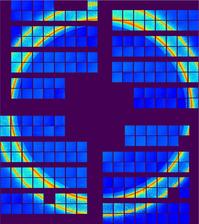X-ray of a crystal. The diffraction pattern results from 34,000 single-pulse x-ray exposures of a krypton jet shortly after the onset of crystal nucleation. The rings indicate x-ray scattering from specific molecular planes within the small crystals. (© European XFEL)
An international team including scientists from DESY has taken a closer look at the formation of the first crystallisation of nuclei in supercooled liquids at European XFEL in Schenefeld near Hamburg. They found: The formation starts much later than previously assumed. The findings could help to better understand the creation of ice in clouds in the future and to describe some processes inside the Earth more precisely.
Every child knows that water freezes into ice when it gets icy cold. For water, this normally happens below zero degrees Celsius, the melting temperature of water. This is a fixed point on the Celsius temperature scale that we use.
However, the transition from the liquid to the solid phase is a very complex process and is difficult to study experimentally at the atomic level. One reason for this is that crystals are formed randomly: You don't know exactly when and where it will happen. Furthermore, a liquid can remain in a metastable state for a long time: It remains liquid even though it should actually freeze and become solid. This makes it extraordinarily difficult to pinpoint the right moment for a crystal to form and watch its growth. However, these effects are highly relevant in nature. For example, they play a decisive role in the formation of ice in clouds or in processes inside Earth.
Using the intense X-ray flashes of the European XFEL's X-ray free-electron laser, an international team of researchers at the European XFEL in Schenefeld near Hamburg has now succeeded in precisely measuring the nucleation of supercooled liquids. The experiments took place in a vacuum so that the X-ray light does not interact with the molecules in the air, which would interfere with the experiments. Because of its complexity, however, water is one of the most difficult liquids to model. For that reason, the researchers used instead argon and krypton in liquid form in their experiments. In fact, supercooled noble-gas liquids are the only systems for which reliable theoretical predictions can be presently made.
The researchers explicitly investigated the so-called crystal nucleation rate J(T). This is a measure of the probability that a crystal will form in a certain volume within a certain time. The rate at which this happens is an important parameter, for example in order to be able to mathematically describe real processes in models – in weather forecasting, for example, or in climate models.
Since it is so difficult to measure real crystal formation, simulations are often used. However, these are associated with major uncertainties. For example, the nucleation rates simulated for water can deviate by several orders of magnitude from those measured experimentally, which makes modelling inaccurate.
The X-ray laser of European XFEL is ideal for investigations of this kind: with the help of intense X-ray flashes, researchers can investigate the very rapid changes in the development of crystallisation.
The team choose the MID instrument (MID = Materials Imaging and Dynamics) for their experiments. They bombarded the liquid jets with X-ray pulses that had an energy of 9.7 kiloelectronvolts (keV). Each X-ray pulse lasted less than 25 femtoseconds – one femtosecond corresponds to one quadrillionth of a second. To illustrate: light travels less than a millimetre in this time.
The experimenters directed the intense X-ray light onto the liquid jet, which was only 3.5 micrometres thin, focusing it on a surface with a diameter of less than one micrometre. In total, the team recorded several million diffraction images in order to have sufficient statistics and to determine the rate of crystal formation with sufficient accuracy.
According to their results, the crystal nucleation rates are much smaller than those predicted on the basis of simulations and the classical theory. "The study promises to significantly expand our understanding of crystallisation," says Johannes Möller from MID instrument of European XFEL. "The results show that the widely used classical theory of the formation of crystals from the liquid phase deviates significantly from reality," explains Möller. "We expect that our approach will allow testing various extensions of the classical theory for predicting crystallisation for the first time," adds Robert Grisenti from GSI Helmholtzzentrum für Schwerionenforschung, the lead author of the study. "Our findings will help theorists to refine their models in the future."
(Partly from European XFEL news; further article in: Physics Magazine - Focus (APS) 'Measuring the First Moments of Crystallization')
Reference:
Crystal Nucleation in Supercooled Atomic Liquids, Johannes Möller et al.,Phys. Rev. Lett. 132, 206102, DOI: 10.1103/PhysRevLett.132.206102








